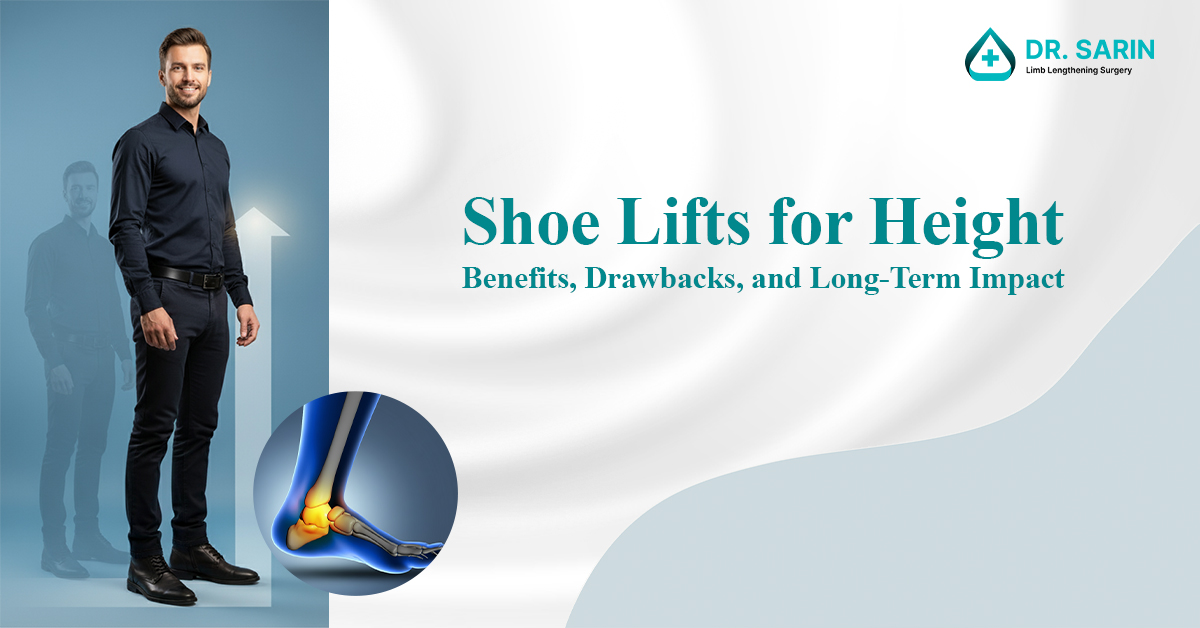Height is something many people wish they had more of. Whether for confidence, social reasons, or professional presence, appearing taller can make a difference. One of the most common short- term solutions is using shoe lift.
Shoe lifts, also called height increasing insoles or heel lifts are often marketed as a simple way to look taller. They are placed inside shoes to add a few extra centimeters to a person’s height. While they may seem harmless, wearing shoe lifts regularly can negatively affect your joints, muscles, posture and psychologically. Here is a detailed look at how shoe lifts impact different parts of the body and the long-term consequences you should know 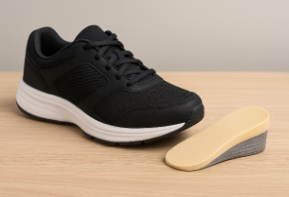
While they work instantly, they also disrupt the body’s natural biomechanics. Over time, this can lead to multiple health problems. Let’s explore each one in detail.
Can Shoe Lifts Cause Plantar Fasciitis or Heel Pain?
Mechanism: Shoe lifts raise the heel, shifting body weight onto the back of the foot. This overstretches the plantar fascia ,the thick band of tissue that runs from the heel to the toes.
Symptoms: Sharp stabbing heel pain especially in the morning or after sitting,tenderness under the arch, and swelling in severe cases.
Long-term Consequence: Chronic plantar fasciitis can limit walking, sports, and daily activities.
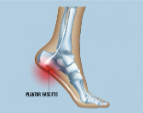
Shoe Lifts and Knee Pain: The Link Explained by Physiotherapists
Mechanism: 5 cm – 8 cm of shoe lifts push the body forward, increasing the angle at which the patella (kneecap) tracks over the femur. This adds stress to the cartilage and surrounding tissues.
Symptoms: Pain around or behind the kneecap, worse during stairs, squatting, or sitting for long periods.
Long-term Consequence: Can progress to patellofemoral pain syndrome or early cartilage wear, raising the risk of osteoarthritis.
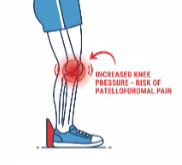
How Shoe Lifts Can Lead to Hip Imbalance and Anterior Pelvic Tilt
Mechanism: Elevating the heel tilts the pelvis forward unnaturally (anterior pelvic tilt). This shortens the hip flexors – iliopsoas, rectus femoris and weakens the gluteal muscles.
Symptoms: Tight hips, reduced flexibility, aching around the hip joints, uneven walking patterns.
Long-term Consequence: Chronic hip pain, imbalance between muscle groups, and inefficient gait that stresses other joints.
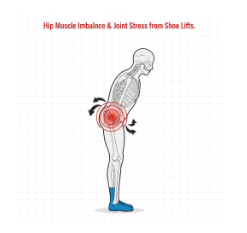
Do Shoe Lifts Affect Posture? Understanding the Risk of Low Back Pain
Mechanism: Shoe lifts elevate the heels, shifting your center of gravity forward. This can lead to an anterior pelvic tilt, increasing the curve in the lower back. This excessive arching puts strain on the lower back muscles and spine, potentially causing pain. Heel lifts can over activate anterior muscles like hip flexors and quadriceps, while weakening posterior muscles like glutes and hamstrings. This imbalance can stress the lower back, as the weakened muscles fail to support the spine properly.
Symptoms: Dull aching pain in the lower back, stiffness, discomfort when standing or walking for prolong time.
Long-term Consequence: Chronic low back pain, disc degeneration, and poor posture that may require rehabilitation.
Heel Lifts and Achilles Tendonitis: What You Need to Know
Mechanism: Since the heel is artificially elevated, the Achilles tendon which connects calf muscles to the heel bone remain in a shortened position all the time during standing ,walking and running so calf muscles and tendon do not get its natural elasticity. Over the time, reduces flexibility of tendon Achilles.
Symptoms: Tight calves, heel pain at the back, tenderness along the tendon, pain during running, jumping and sport activities.
Long-term Consequence: Achilles tendonitis, chronic stiffness, and even risk of tendon rupture with sudden stress.
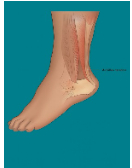
How Height Increasing Insoles Can Lead to Calf Muscle Stiffness
Mechanism: Similar to the Achilles, the gastrocnemius and soleus muscles stay in a shortened position with lifts. This reduces ankle dorsiflexion range of motion.
Symptoms: Cramping, fatigue, reduced ability to stretch calves fully, discomfort during sports.
Long-term Consequence: Limited ankle mobility, poor athletic performance, and higher risk of injuries.
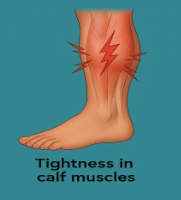
How Shoe Lifts Affect Balance, Gait, and Walking Mechanics
Mechanism:
1. Shoe lift changes the natural alignment of the foot, ankle, knee, hip, and spine. This shifts the body’s center of gravity forward
- Altered Gait
- The stride length may shorten.
- The ankle joint has to work harder to push off.
- The knee and hip compensate
- Toe tip walk
2. Reduced Stability: These changes make it harder for the body to maintain balance, especially on uneven ground, stairs, or when changing direction quickly. This increases the risk of tripping or falls.
3. Muscle & Joint Stress: The imbalance forces certain muscles (like calf, quadriceps, and back muscles) to overwork, which can cause fatigue, soreness, or even long-term joint strain.
Symptoms: Wobbling inside shoes, ankle instability, difficulty balancing on uneven surfac.
Long-term Consequences: Altered walking patterns that stress multiple joints, increasing injury risk.
Psychological Effects of Wearing Shoe Lifts Daily
Shoe lifts provide a quick confidence boost, but users may begin to rely on them emotionally. Without them, they may feel shorter, insecure, or anxious. Fear of social settings without lifts, low self-esteem when barefoot or in flat shoes, reduced confidence, body-image issues, and dependence on external aids instead of long-term solutions.
Why This Matters
Most of these issues start with mild discomfort in the feet or back but with daily, long-term use, they can lead into chronic pain, joint degeneration, and reduced mobility.
Safer Use of Shoe Lifts
- Use occasionally, not daily.
- Keep lifts under 2 cm to minimize strain.
- Choose ergonomic, cushioned designs if you must wear them.
For permanent height gain, consider medical evaluation for limb lengthening surgery
FAQ: About Shoe Lifts for Height
Q. If I’m considering limb lengthening surgery in future. Can I wear the shoe-lifts?
Ans: If you wear shoe lifts, it can cause your iliopsoas muscles to tighten, along with ankle stiffness and calf muscle tightness. Before limb lengthening surgery, this type of muscle imbalance and stiffness is not ideal, because it can make recovery and rehabilitation more difficult. Post surgery you may developed severe hyperlodrosis and ballerina syndrome It’s better to keep your muscles flexible and well balanced before surgery.
Q. Can I wear shoe lifts post limb lengthening surgery?
Ans: After limb lengthening surgery, it’s not recommended to wear shoe lifts during the recovery and rehabilitation phase.
- Muscle Tightness: Shoe lifts can cause tightness in the iliopsoas, calf, and ankle joint, which are already stressed during lengthening.
- Balance & Gait: They disturb your walking pattern, making it harder to relearn proper gait in
physiotherapy. - Joint Stress: Extra lift changes biomechanics, adding strain on the hips, knees, and lower back.
- Rehab Interference: The goal after surgery is normal alignment, flexibility, and strength. Shoe lifts can slow this progress.
Once you are fully recovered, you may wear shoe lifts occasionally if you wish. But if you are planning a second stage of limb lengthening, you should avoid shoe lifts completely, as they can cause stiffness and make the next surgery and rehab more difficult.
Q. Limb lengthening vs Shoe-lifts which one should I choose?
Ans: Limb Lengthening vs. Shoe Lifts for Height
Shoe Lifts:
- Quick, non-surgical way to look taller.
- Inexpensive and easy to use.
- Temporary height gain disappears when removed.
- Long-term use can cause calf tightness, ankle stiffness, hip and back pain.
- Can create psychological dependence ,feeling insecure without them
Limb Lengthening Surgery:
- Permanent increase in height.
- Improves confidence without relying on external aids.
- Results look and feel natural once recovery is complete.
- Requires surgery, time for bone healing, and dedicated physiotherapy.
- Higher cost compared to shoe lifts.
Shoe lifts may be fine for short-term or occasional use, but they come with physical and emotional downsides.
Limb lengthening is the only permanent solution for height increase, but time taking and financial burden
My Observation on Shoe Lifts and Limb Lengthening Surgery
What I Learned From 1000+ Patients?
As a physiotherapist specializing in limb lengthening rehabilitation, I have had the opportunity to work with more than 1000 patients over the last decade. One of the most important lessons I’ve learned is how something as simple as shoe lifts can make a huge difference in the long-term outcome of surgery.
The Problem with Long-Term Shoe Lifts
Many patients who underwent limb lengthening surgery used shoe lifts continuously for more than two years. Over time, I noticed a common trend in this group:
- They developed tightness(Reduced range of motion) in the ankle joint.
- The Achilles tendon became stiff and shortened.
- The calf muscles lost flexibility.
These patients struggled to lengthen beyond 5 cm on the tibia. Any attempt to go further often led to complications such as ballerina syndrome (toe-walking due to tendon tightness).
Patients Without Shoe Lifts
Interestingly, patients who did not depend on shoe lifts showed a very different outcome. Their ankle joints stayed more flexible, and they could comfortably lengthen up to 7–8 cm on the tibia without significant risk of ballerina syndrome.
Why This Happens?
Shoe lifts create an artificial elevation of the heel, which changes the natural biomechanics of the ankle and calf. Over time, this constant position causes
- Shortening of the Achilles tendon
- Reduced dorsiflexion (ankle flexibility)
- Increased calf muscle tightness
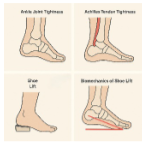
When someone always wears high-heeled shoes or shoe-lifts the muscles and tendons adapt to the shortened position and lose flexibility.
How to Prevent These Issues?
For patients undergoing limb lengthening in future, here are some important tips to protect ankle mobility
- Use shoe lifts only when absolutely necessary, and avoid long-term dependency.
- Daily stretching of the Achilles tendon and calf muscles is essential.
- Ankle mobility exercises (such as dorsiflexion stretches and resistance band movements) should be a regular part of rehab.
- Physiotherapy sessions help detect tightness early and correct it before it becomes a major barrier.
My Takeaway
Every small decision matters during the limb lengthening journey. While shoe lifts may seem like a convenient solution, relying on them for years can silently harm ankle flexibility and tendon health. From my experience, patients who avoided long-term shoe lifts generally had smoother recovery and were able to achieve greater lengthening goals without major complications
You May Also Like to Know:

